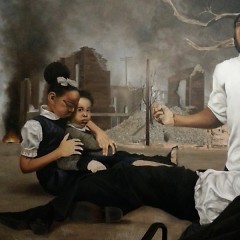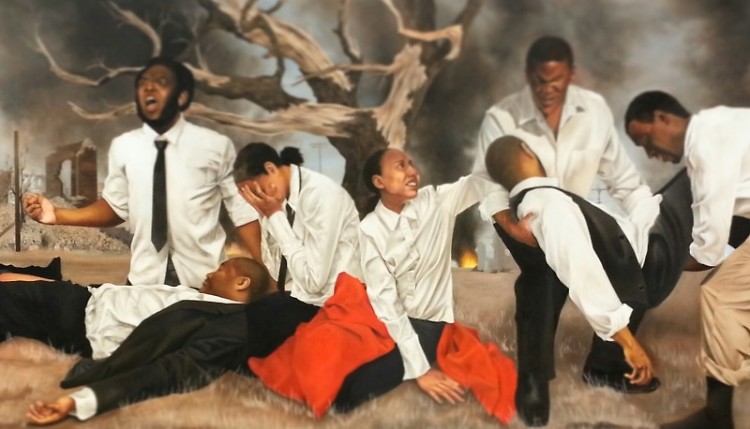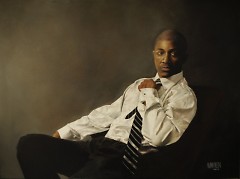Shawn Michael Warren, a representational oil painter, did not come from Harvey, IL to Grand Rapids, MI to win ArtPrize. However, his painting, in the top 25 of the 2-D category right now, is achieving his goal of calling attention to moments in history that are disputable.
Warren will be at ArtPrize for the duration fhe 19-day international art festival, with his painting“In a Promised Land…” The first in a series of works on this subject, the artist visualizes the tragedy of racial violence that took place in Tulsa in 1921.
The painting spans 15 feet wide by eight feet tall and is displayed in the northwest corner on the upper level at DeVos Place. The sublime beauty of Warren’s painting style combined with the absence of blood and gore makes the subject matter accessible, so that people linger and look closely at the scene of destruction and emotional upheaval. The artist’s friends and family members modeled as the painting’s subjects in order to help Warren achieve the composition he envisioned.
“What he has done to capture the emotion and the pain people were feeling is just remarkable,” commented Denise Bruner, a visitor from Arlington, VA. “To just see the background and all the violence around them although you don’t really see exactly what happened you see the results of it—a very moving piece. I’m glad I saw it because now I am going to study about what happened. I had no idea.”
Gene Brady, a visitor from the Detroit area, had a more visceral response to the image.
“It made me sick to my stomach then I got a chill and then I felt embarrassed that I didn’t know about this when I should have,” Brady reacted.
“I talked to the artist,” Brady continued, “He told me that they still have no idea how many people died, and [we’re] going on 100 years later. Reading the newspaper clippings [displayed] over there—they were trying to shut the story up so nobody knew about it. There was a report that actually there were 300 African Americans that died. But so many people left Tulsa immediately after that it could have been 500 for all we know. It would make it the biggest race riot in American history that nobody has heard about.”
“And we’re doing the same thing today, in Ferguson and all these other cities we are repeating what happened in Tulsa in 1921. That’s why it’s wonderful that this artist will bring it out into the open. It gives us perspective,” Brady concludes.
“It’s unfortunate that we don’t learn about this part of American History,” Warren notices, “a lot of things are being changed or omitted or completely left out.”
Given the title “Black Wall Street,” Northern Tulsa was predominantly composed of Black residents who controlled banks, their own newspapers, transportation and oil. When oil was struck in 1907, Tulsa grew exponentially in terms of economics as well as population.
“From 1906 to 1921, the year of the riot, the population grew from 1,300 to 100,000,” Warren explains. “The Black residents in that area were very affluent, wealthy people but in the neighboring parts of Tulsa there were poor impoverished white communities. Along with racial tensions in that area just 60 year after slavery had ended there was also inferiority in regards to class.”
“So what started the riot on June 1 of 1921 was pretty much a lie, a fabricated story that a young Black shoe-shiner had assaulted a white lady in an elevator. Word had gotten out that he was taken into police custody and a rumor was spread among the white communities in Tulsa. They gathered mobs, led by the Ku Klux Klan and walked into city hall. When the young man was actually declared innocent and cleared of any wrongdoing, there was outrage from the white community. From that, gunshots started, chaos broke out and the riot ensued. In one night 40 blocks of black owned businesses and homes were reduced to rubble,” says Warren.
“Martial law was declared at one point by the Tulsa governor," he continues. "There were many Black residents rounded up by police and taken to what really you can call concentration camps. Most of them lived in tents during that time, so it is referred to as the Black Holocaust. Eventually the city was rebuilt but nothing was the same, nothing was solely Black owned or controlled.”
For more information about the history of Tulsa 1921 Warren recommends “Death in a Promised Land,” by Scott Ellsworth.
Kate Lewis is currently curating Neighbor Gallery, a pop-up First Friday exhibition space at 42 S. Division where there is a focus on art, activism and community building. As a part of a goal to take discussions deeper, she is writing on arts and activism in the Grand Rapids community.
The Rapidian, a program of the 501(c)3 nonprofit Community Media Center, relies on the community’s support to help cover the cost of training reporters and publishing content.
We need your help.
If each of our readers and content creators who values this community platform help support its creation and maintenance, The Rapidian can continue to educate and facilitate a conversation around issues for years to come.
Please support The Rapidian and make a contribution today.


